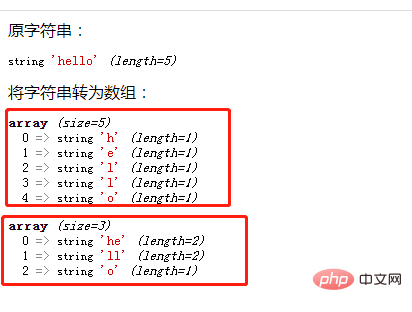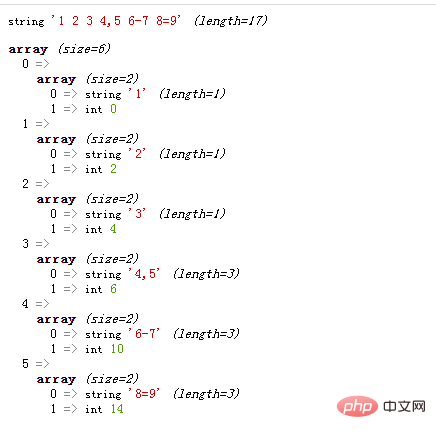Can strings be converted into arrays in php?
php strings can be converted into arrays. 5 conversion methods: 1. Use "str_split (string, element length)" to convert the string into an array; 2. Use "explode (separator, string)" to convert the string into an array; 3. Use "preg_split" ('match pattern', string, -1, $flags)" to convert; 4. Use "settype (string, "array")" to convert; 5. Add parentheses before the string variable Target type "(array)".

The operating environment of this tutorial: windows7 system, PHP8.1 version, DELL G3 computer
The string in php can be converted into array. In php, there are many ways to convert strings into arrays.
Method 1: Use the str_split() function
The str_split() function splits the string into an array, that is, converts the string into a character array.
str_split(string,length)
The parameter description is as follows:
string Required. Specifies the string to be split.
#length Optional. Specifies the length of each array element. The default is 1.
<?php header('content-type:text/html;charset=utf-8'); $str = 'hello'; echo "原字符串:"; var_dump($str); echo "将字符串转为数组:"; $arr1=str_split($str); var_dump($arr1); $arr2=str_split($str,2); var_dump($arr2); ?>

Method 2: Use the explode() function
explode() function can be based on strings The delimiter splits the string, that is, it splits a string into several substrings based on the delimiter, and then combines these substrings into an array and returns it.
explode($delimiter, $string [, $limit])
The parameter description is as follows:
- $delimiter: The delimiter character used to split the string;
- $string: The string that needs to be split;
-
$limit: Optional parameter, can be empty, specifies the number of array elements to be returned;
- If $limit is not empty and is a positive number, the returned array contains at most $limit elements, and the last element contains the remainder of $string;
- If $limit is not empty and is negative, all elements except the last $limit elements are returned;
- If $limit is 0, it will be treated as 1;
- If $limit is empty, all array elements are returned.
Example:
<?php
header('content-type:text/html;charset=utf-8');
$str = 'hypertext language programming';
echo "原字符串:";
var_dump($str);
echo "将字符串转为数组(分割符为空格):";
$arr=explode(" ",$str);
var_dump($arr);
?>
Method 3. Use the preg_split() function--- Convert the string into an array
preg_split() function splits the string through a regular expression.
preg_split ( string $pattern , string $subject [, int $limit = -1 [, int $flags = 0 ]] )
The parameter description is as follows:
- $pattern: The pattern used for matching, that is, the regular expression.
- $subject The string to be split.
- $limit: Optional parameter. If specified, the substrings obtained by limiting the separation will be limited to at most limit, and the last substring will contain all remaining parts. When the limit value is -1, 0 or NULL, it means "no limit". It is recommended to use NULL.
- $flags: optional parameter, which has 3 values.
- If set to PREG_SPLIT_NO_EMPTY, preg_split() will return the separated non-empty part.
- If set to PREG_SPLIT_DELIM_CAPTURE, bracket expressions in delimited patterns will be captured and returned.
- If set to PREG_SPLIT_OFFSET_CAPTURE, the string offset will be appended to the return for each occurrence of a match.
Note: This will change each element in the returned array so that each element becomes an array consisting of the 0th element being the separated substring and the 1st element being the offset of the substring in the subject. .
Return value: Returns an array composed of substrings obtained after using $pattern to split the subject string.
Example:
<?php header('content-type:text/html;charset=utf-8'); $str = '1 2 3 4,5 6-7 8=9'; var_dump($str); $arr=preg_split('/ /', $str, -1, PREG_SPLIT_OFFSET_CAPTURE); var_dump($arr); ?>

Method 4: Use the settype() function
The settype() function can re Set the type of the variable and convert the type of the string variable to an array.
settype($var,$type)
The parameter description is as follows:
$var: the variable to be converted.
$type: required data type.
Just set $type to ""array"" to set the variable $var to the array type.
Note: The settype() function will change the original variable, returning TRUE if the setting is successful and FALSE if it fails.
<?php header('content-type:text/html;charset=utf-8'); $str = 'hello world!'; echo "原字符串:"; var_dump($str); echo "将字符串转为数组类型:"; $arr=settype($str,"array"); var_dump($str); var_dump($arr); ?>

Method 5: Add the target type "(array)" enclosed in brackets before the string variable
(array): Force the specified variable into an array type;
<?php header('content-type:text/html;charset=utf-8'); $str = 'hello world!'; echo "原字符串:"; var_dump($str); echo "将字符串转为数组类型:"; $arr=(array)$str; var_dump($arr); ?>
推荐学习:《PHP视频教程》
The above is the detailed content of Can strings be converted into arrays in php?. For more information, please follow other related articles on the PHP Chinese website!

Hot AI Tools

Undresser.AI Undress
AI-powered app for creating realistic nude photos

AI Clothes Remover
Online AI tool for removing clothes from photos.

Undress AI Tool
Undress images for free

Clothoff.io
AI clothes remover

Video Face Swap
Swap faces in any video effortlessly with our completely free AI face swap tool!

Hot Article

Hot Tools

Notepad++7.3.1
Easy-to-use and free code editor

SublimeText3 Chinese version
Chinese version, very easy to use

Zend Studio 13.0.1
Powerful PHP integrated development environment

Dreamweaver CS6
Visual web development tools

SublimeText3 Mac version
God-level code editing software (SublimeText3)

Hot Topics
 1664
1664
 14
14
 1423
1423
 52
52
 1318
1318
 25
25
 1269
1269
 29
29
 1248
1248
 24
24
 Explain JSON Web Tokens (JWT) and their use case in PHP APIs.
Apr 05, 2025 am 12:04 AM
Explain JSON Web Tokens (JWT) and their use case in PHP APIs.
Apr 05, 2025 am 12:04 AM
JWT is an open standard based on JSON, used to securely transmit information between parties, mainly for identity authentication and information exchange. 1. JWT consists of three parts: Header, Payload and Signature. 2. The working principle of JWT includes three steps: generating JWT, verifying JWT and parsing Payload. 3. When using JWT for authentication in PHP, JWT can be generated and verified, and user role and permission information can be included in advanced usage. 4. Common errors include signature verification failure, token expiration, and payload oversized. Debugging skills include using debugging tools and logging. 5. Performance optimization and best practices include using appropriate signature algorithms, setting validity periods reasonably,
 PHP Program to Count Vowels in a String
Feb 07, 2025 pm 12:12 PM
PHP Program to Count Vowels in a String
Feb 07, 2025 pm 12:12 PM
A string is a sequence of characters, including letters, numbers, and symbols. This tutorial will learn how to calculate the number of vowels in a given string in PHP using different methods. The vowels in English are a, e, i, o, u, and they can be uppercase or lowercase. What is a vowel? Vowels are alphabetic characters that represent a specific pronunciation. There are five vowels in English, including uppercase and lowercase: a, e, i, o, u Example 1 Input: String = "Tutorialspoint" Output: 6 explain The vowels in the string "Tutorialspoint" are u, o, i, a, o, i. There are 6 yuan in total
 Explain late static binding in PHP (static::).
Apr 03, 2025 am 12:04 AM
Explain late static binding in PHP (static::).
Apr 03, 2025 am 12:04 AM
Static binding (static::) implements late static binding (LSB) in PHP, allowing calling classes to be referenced in static contexts rather than defining classes. 1) The parsing process is performed at runtime, 2) Look up the call class in the inheritance relationship, 3) It may bring performance overhead.
 What are PHP magic methods (__construct, __destruct, __call, __get, __set, etc.) and provide use cases?
Apr 03, 2025 am 12:03 AM
What are PHP magic methods (__construct, __destruct, __call, __get, __set, etc.) and provide use cases?
Apr 03, 2025 am 12:03 AM
What are the magic methods of PHP? PHP's magic methods include: 1.\_\_construct, used to initialize objects; 2.\_\_destruct, used to clean up resources; 3.\_\_call, handle non-existent method calls; 4.\_\_get, implement dynamic attribute access; 5.\_\_set, implement dynamic attribute settings. These methods are automatically called in certain situations, improving code flexibility and efficiency.
 PHP and Python: Comparing Two Popular Programming Languages
Apr 14, 2025 am 12:13 AM
PHP and Python: Comparing Two Popular Programming Languages
Apr 14, 2025 am 12:13 AM
PHP and Python each have their own advantages, and choose according to project requirements. 1.PHP is suitable for web development, especially for rapid development and maintenance of websites. 2. Python is suitable for data science, machine learning and artificial intelligence, with concise syntax and suitable for beginners.
 PHP in Action: Real-World Examples and Applications
Apr 14, 2025 am 12:19 AM
PHP in Action: Real-World Examples and Applications
Apr 14, 2025 am 12:19 AM
PHP is widely used in e-commerce, content management systems and API development. 1) E-commerce: used for shopping cart function and payment processing. 2) Content management system: used for dynamic content generation and user management. 3) API development: used for RESTful API development and API security. Through performance optimization and best practices, the efficiency and maintainability of PHP applications are improved.
 PHP: A Key Language for Web Development
Apr 13, 2025 am 12:08 AM
PHP: A Key Language for Web Development
Apr 13, 2025 am 12:08 AM
PHP is a scripting language widely used on the server side, especially suitable for web development. 1.PHP can embed HTML, process HTTP requests and responses, and supports a variety of databases. 2.PHP is used to generate dynamic web content, process form data, access databases, etc., with strong community support and open source resources. 3. PHP is an interpreted language, and the execution process includes lexical analysis, grammatical analysis, compilation and execution. 4.PHP can be combined with MySQL for advanced applications such as user registration systems. 5. When debugging PHP, you can use functions such as error_reporting() and var_dump(). 6. Optimize PHP code to use caching mechanisms, optimize database queries and use built-in functions. 7
 The Enduring Relevance of PHP: Is It Still Alive?
Apr 14, 2025 am 12:12 AM
The Enduring Relevance of PHP: Is It Still Alive?
Apr 14, 2025 am 12:12 AM
PHP is still dynamic and still occupies an important position in the field of modern programming. 1) PHP's simplicity and powerful community support make it widely used in web development; 2) Its flexibility and stability make it outstanding in handling web forms, database operations and file processing; 3) PHP is constantly evolving and optimizing, suitable for beginners and experienced developers.





